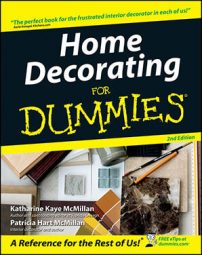Formal dining rooms make even ordinary menus seem extraordinary. A fancy dining room can double as an elegant library or study (and with a hideaway armoire for the PC, perhaps a home office) between dining occasions. Whether or not your formal dining room does double-duty, decorate it with comfort, movement, color, texture, pattern, furniture, china and glassware, linens, and storage in mind.
For the most part, the furniture you need in a dining room is basic a table and chairs. Your first obligation is to make sure your guests have adequate room. After your guests are comfortable, you can consider adding a china cabinet, which is an impressive element in a dining room but can be housed nearby if necessary. A china cabinet with a lighted, mirrored back and glass shelves adds a sense of depth, sparkle, and glamour and also provides practical storage. Buffets and servers add much-need surface for stacking plates and foods to be served in courses.
In many people’s minds, formality translates to discomfort. But you and your family can be comfortable. Think about what makes you comfortable, and incorporate those things into your design. Take a look at the following suggestions for comfort:
Control the room’s sound: The noise level should be neither deathly quiet nor too loud. Fabrics (including rugs, tablecloths, and draperies) absorb sound. If your dining room is wired for music, so much the better, because soft music is a delightful sound for guests to hear as they enter the room.
Find the right lighting level: Make lighting bright enough that diners can see what they’re eating, but keep light levels low enough for a relaxed mood. For a lighting level that’s just right, control overhead lights with a dimmer switch or use indirect lighting. Keep candles above or below, but never directly at, eye level and surround them with hurricane globes to prevent wild flickering.
Opt for comfortable seating: Padded chair seats fill the bill. A fully upholstered (seat and back) chair is most expensive. Upholstered slip seats, which unscrew for quick and easy recovering, are less costly. A thick, tie-on cushion is least expensive. For peace of mind, select a stainproof, wipe-clean fabric or material for chair covers.
Your family and guests need to be able to move in and out of their chairs without asking permission, bumping into each other, or knocking over their water glass. So leave 1-1/2 to 2 feet between chairs, and add casters to the bottoms of chairs for easier movement.
Traffic should flow around the table and seated guests, so leave at least 2 feet for passage of one person and up to 3 or 4 feet for people who are serving from heavy trays. If your dining room is small and leaves little or no room for a china cabinet or additional furniture, face up to it. Position those items in a hallway or living room.

